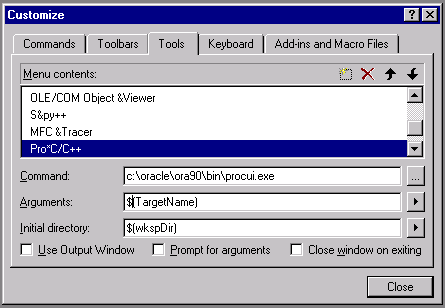Release 9.2 for Windows
Part Number A96111-01
Home |
Book List |
Contents |
Index |
 Master Index |
 Feedback |
| Pro*C/C++ Precompiler Getting Started Release 9.2 for Windows Part Number A96111-01 |
|
This appendix describes how to integrate Pro*C/C++ into the Microsoft Visual C++ integrated development environment.
This appendix contains these topics:
This section describes how to fully integrate Pro*C/C++ within Microsoft Visual C++ projects.
All the precompiler errors and warnings are displayed in the output box where Microsoft Visual C++ displays compiler and linker messages. You do not have to precompile a file separately from the Microsoft Visual C++ build environment. More importantly, Microsoft Visual C++ maintains the dependencies between .c and .pc files. Microsoft Visual C++ maintains the dependency and precompile files, if needed.
All of the procedures in this section are performed within Microsoft Visual C++.
For Microsoft Visual C++ to run Pro*C/C++, it must know the location of the Pro*C/C++ executable. If Microsoft Visual C++ was installed before any Oracle release 9.2 products were installed, then you must add the directory path.
To specify the location of the Pro*C/C++ executable:
ORACLE_BASE\ORACLE_HOME\bin directory. For example:C:\oracle\ora92\bin
To specify the location of the Pro*C/C++ header files:
ORACLE_BASE\ORACLE_HOME\precomp\public directory. For example:
C:\oracle\ora92\precomp\public
After you create a project, you need to add the .pc file(s).
To add a .pc file to a project:
For each .pc file, you need to add a reference to the .c file that will result from precompiling.
To add a reference to a .c file to a project:
.c file in the File Name box..c file has not been created yet, Microsoft Visual C++ displays the following message: "The specified file does not exist. Do you want to add a reference to the project anyway?"Pro*C/C++ applications must link with the library file orasql9.lib.
To add the Pro*C/C++ library to a project:
orasql9.lib from the ORACLE_BASE\ORACLE_HOME\precomp\lib\msvc directory.To specify custom build options:
.pc file and choose Settings. The Project Settings dialog box appears with the Custom Build tab displayed.
$ORACLE_HOME setting..c files, then enter $(ProjDir)\$(InputName).c..cpp files, then enter $(ProjDir)\$(InputName).cpp.$(ProjDir) and $MSDEVDIR are macros for custom build commands in Microsoft Visual C++. When the project is built, Microsoft Visual C++ checks the date of the output files to determine whether they need to be rebuilt for any new modifications made to the source code.
You can include Pro*C/C++ as a choice in the Tools menu of Microsoft Visual C++.
To add Pro*C/C++ to the Tools menu:
Pro*C/C++
C:\oracle\ora92\bin\procui.exe
$(TargetName)
When you choose Pro*C/C++ from the Tools menu, Microsoft Visual C++ uses the $(TargetName) argument to pass the name of the current development project to Pro*C/C++. Pro*C/C++ then opens a precompile project with the same name as the opened project, but with a .pre extension in the project directory.
$(WkspDir)
The Customize dialog box should now look like the following graphic (although the Oracle home directory may be different on your computer).

Text description of the illustration ms1.gif
|
 Copyright © 1994, 2002 Oracle Corporation. All Rights Reserved. |
|